Drowning in data but starved for insights?
You have plenty of numbers, but connecting them to actual customer behavior and revenue growth feels like a constant struggle.
This leads to guesswork, and wasting your precious marketing budget on ineffective channels is a constant, nagging fear for any growth lead.
The pressure to perform is only increasing. LLCBuddy reports U.S. ecommerce sales are reflecting a 7.6% growth, making data-driven decisions essential for survival.
For a broader perspective on leveraging data, my guide on best marketing analytics tools offers deeper insights.
Thankfully, the right tool changes this by helping you turn raw data into clear actions that propel sustainable revenue growth.
In this guide, I’ll show you my top picks for the best ecommerce analytics tools. These are designed to unify your data and finally give you the clarity you need.
You’ll find solutions that automate reporting, reveal key conversion drivers, and integrate easily with the rest of your ecommerce stack.
Let’s dive in.
Quick Summary:
| # | Software | Rating | Best For |
|---|---|---|---|
| 1 | Hotjar → | Ecommerce marketing managers | |
| 2 | Google Analytics → | Brands needing unified data | |
| 3 | Shopify → | Scaling ecommerce startups | |
| 4 | Mixpanel → | Marketing teams needing fast insights | |
| 5 | Woopra → | Growth leads seeking real-time data |
1. Hotjar
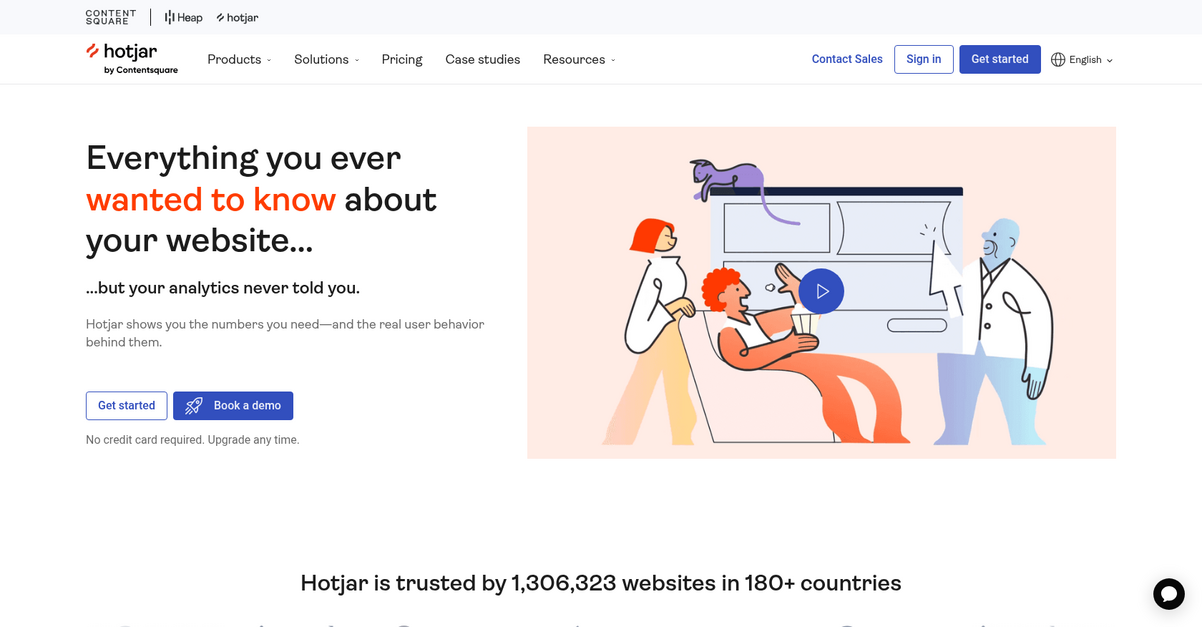
Still guessing what your ecommerce customers truly want?
Your existing analytics might show numbers, but Hotjar reveals the actual user behavior behind those figures. This means you can finally understand why visitors aren’t converting.
This tool helps identify which page elements drive sales and sign-ups, and which are ignored, ensuring you make changes that truly impact your bottom line.
Stop making assumptions and start acting.
Hotjar brings together observation, feedback, and engagement tools, eliminating the need for multiple platforms. You can leverage heatmaps to visualize user interaction and watch recordings of real sessions to pinpoint friction points.
Additionally, you can hear directly from your users through feedback buttons and surveys, giving you direct insight into what you love or what makes them bounce. This direct feedback is invaluable for validating your plans, measuring satisfaction, and learning from churn. Plus, you can conduct 1-to-1 interviews to test hypotheses and refine designs, empowering you to make data-backed decisions that propel growth.
This comprehensive approach allows you to uncover high-impact optimization opportunities, spot experience problems before they hurt sales, and gain buy-in for new ideas with concrete evidence.
Hotjar illuminates your data.
Key features:
- Heatmaps and Recordings: Visualize user behavior on your site with heatmaps to see what’s ignored or drives sales, and watch session recordings to find hidden friction.
- Feedback and Surveys: Gather direct user input through feedback buttons and surveys to understand what users love, what drives them away, and validate your business plans.
- User Interviews and Integrations: Connect 1-to-1 with users for deeper insights and seamlessly integrate with tools like Google Analytics, Unbounce, and Zapier for unified analysis.
Hotjar features, pricing, & alternatives →
Verdict: If you’re an ecommerce marketing manager or growth lead aiming for real-time, unified visibility and automated insights, Hotjar is one of the best ecommerce analytics tools you can leverage. Its blend of quantitative data with qualitative user feedback, like HubSpot Academy boosting signups by 10% using surveys, ensures you can make truly evidence-based marketing decisions.
2. Google Analytics
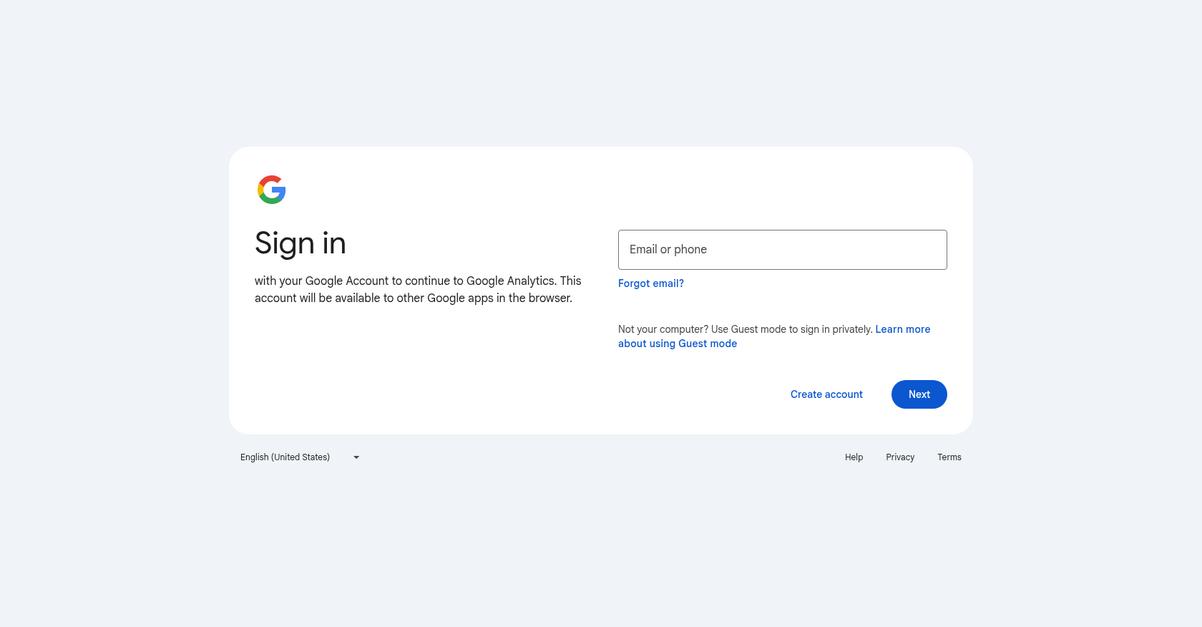
Is your ecommerce data scattered and hard to interpret? You’re not alone.
Google Analytics helps solve this by centralizing your customer and channel data, providing a unified view. This means you can finally see the full picture of your customer’s journey.
You often grapple with fragmented insights that hinder swift, impactful decisions. This tool connects the dots, letting you understand behavior and refine your strategies.
Here’s how to unlock better insights.
Google Analytics provides the unified visibility you crave, offering powerful reporting and analysis features. This empowers you to truly understand your online store’s performance.
You can gain real-time insights into customer journeys, allowing you to adapt quickly to trends and optimize your marketing efforts for better results. The platform also accelerates your reporting, helping you automate key insights and support data-driven decisions that propel growth.
Additionally, it helps you measure your marketing ROI and understand what drives conversions, ensuring your spend is effective. You can track user behavior across various touchpoints, identifying areas for improvement and maximizing your revenue potential.
Finally, empower your growth decisions.
Key features:
- Unified Data View: Centralizes customer and channel data, providing a single source of truth for understanding your ecommerce performance and identifying growth opportunities.
- Real-time Insights: Offers immediate visibility into customer journeys and conversion drivers, enabling rapid response to market changes and optimization of marketing strategies.
- Automated Reporting: Accelerates reporting processes and automates key insights, supporting evidence-based marketing decisions and driving operational efficiency.
Google Analytics features, pricing, & alternatives →
Verdict: Google Analytics is among the best Ecommerce Analytics Tools for brands seeking unified data visibility and actionable insights. It addresses pain points like fragmented data and slow reporting by centralizing information and automating key metrics, helping you confidently justify marketing spend and accelerate revenue growth.
3. Shopify

Are you struggling with fragmented ecommerce data?
Shopify offers analytics and reporting, allowing you to gain customer insights and track sales and orders, providing the unified visibility you need. This means you can measure your performance effectively.
It helps solve the pain point of outgrowing basic reporting platforms by providing powerful tools to track sales, orders, and analytics.
Get real-time insights to propel growth.
Shopify allows you to manage everything in one place with its fully centralized Shopify Admin, giving you control from the back office to the front of the store. You can manage your stock and orders, automate tasks with Shopify Flow, and even handle international sales with Shopify Markets. This comprehensive approach means you can cut acquisition costs and foster customer loyalty, which is crucial for sustainable revenue growth. Additionally, Shopify Magic taps into AI to generate product content and suggest optimization, accelerating your reporting and automating key insights.
You can also leverage Shopify Audiences to reach the right customers, cutting acquisition costs as much as 50%, keeping them coming back with integrated marketing tools and insightful analytics.
Know your audience and track performance.
Key features:
- Centralized Analytics and Reporting: Gain unified visibility into sales, orders, and customer behavior, helping you make data-driven decisions to boost revenue.
- Integrated Marketing and Customer Insights: Leverage tools like Shopify Audiences and Email to understand your customers better and retain them effectively.
- AI-Powered Optimization and Automation: Utilize Shopify Magic for content generation and Flow for task automation, enhancing efficiency and accelerating reporting.
Shopify features, pricing, & alternatives →
Verdict: For ecommerce marketing managers and growth leads at scaling startups, Shopify stands out as one of the best Ecommerce Analytics Tools because its centralized platform and integrated insights solve data fragmentation challenges. It combines powerful analytics with marketing automation, making it easier to track performance and accelerate growth, ensuring a measurable ROI.
4. Mixpanel

Struggling with fragmented data and slow insights?
Mixpanel’s product analytics help you measure and optimize your ecommerce efforts. This means you can finally get clear answers about customer behavior.
You’ll empower your teams to self-serve trusted data, transforming data into clear, actionable impact.
Get answers, fast.
Mixpanel makes it easy to get answers, make decisions, and show the impact of your product and marketing investments. You can access data instantly, with intuitive dashboards that require no SQL or analytics background.
Session Replay unifies qualitative and quantitative data, helping you understand the real impact on marketing, support, and billing. Additionally, its integrated data features break down silos by bringing all your key metrics into one self-serve platform. Plus, you can easily connect your data warehouse or CDP for even deeper insights.
The result? You’ll stop guessing and start measuring.
While we’re discussing customer insights, understanding customer retention strategies is equally important for sustained success.
Key features:
- Product Analytics & Session Replay: Measure and optimize products by watching user journeys, connecting trusted business data with product data for clear impact.
- Warehouse Connectors & Integrations: Sync trusted data from your warehouse or other tools, allowing you to break down silos and unify all your key metrics in one place.
- Self-Serve Data & Empowered Teams: Intuitive dashboards allow everyone to access data instantly without SQL, helping your teams self-serve trusted data and make efficient decisions.
Mixpanel features, pricing, & alternatives →
Verdict: Mixpanel is an excellent choice among the best ecommerce analytics tools for marketing managers and growth leads seeking unified data and actionable insights. Over 29,000 companies accelerate growth by using its intuitive dashboards and Session Replay, directly addressing challenges like fragmented data and slow reporting to drive measurable ROI.
5. Woopra
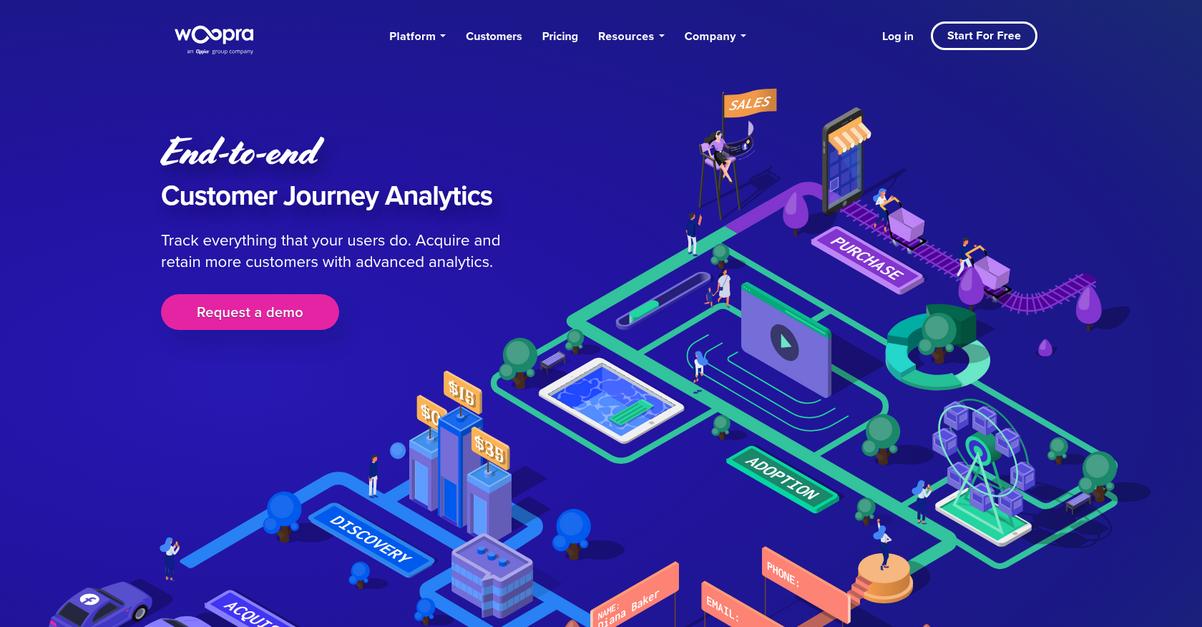
Struggling with fragmented customer data in your e-commerce business?
Woopra provides end-to-end customer journey analytics, unifying data across product, marketing, sales, and support. This means you can track everything your users do to acquire and retain more customers.
Woopra helps you gain immediate insights into the end-to-end customer journey with full historical data, serving as your ultimate source of truth.
You need immediate, unified customer insights.
Woopra unifies customer data from over 50 integrations and custom tracking, ensuring you see the full picture. This enables you to analyze customer journeys, trends, retention, and segmentation, providing answers to any business question.
You can examine every user and every action they’ve taken in real-time with People Profiles, seeing who is interacting with your website or making payments. Additionally, its easy-to-use visual interface allows anyone to quickly answer questions without writing a single line of code. Plus, you can take real-time action by triggering personalized interactions with built-in automation. The result is data-driven decisions, made fast.
Knowing what your customers are doing is crucial.
Key features:
- End-to-end customer journey analytics: Track every user action and unify data across product, marketing, sales, and support touchpoints to acquire and retain more customers effectively.
- Real-time individual-level analysis: Examine every user and their actions instantly with People Profiles, revealing who is engaging with your site, making payments, and using key features.
- Built-in automation and integrations: Take real-time action with triggers like personalized emails and Slack messages, syncing data across 50+ integrations for deep, meaningful customer interactions.
Woopra features, pricing, & alternatives →
Verdict: Woopra is ideal for marketing and growth leads seeking the best ecommerce analytics tools, as it provides real-time, unified insights into customer journeys. Its ability to sync existing user data, analyze individual behavior, and automate actions empowers your team to make data-driven decisions that drive acquisition, engagement, and retention across every touchpoint.
6. Glew
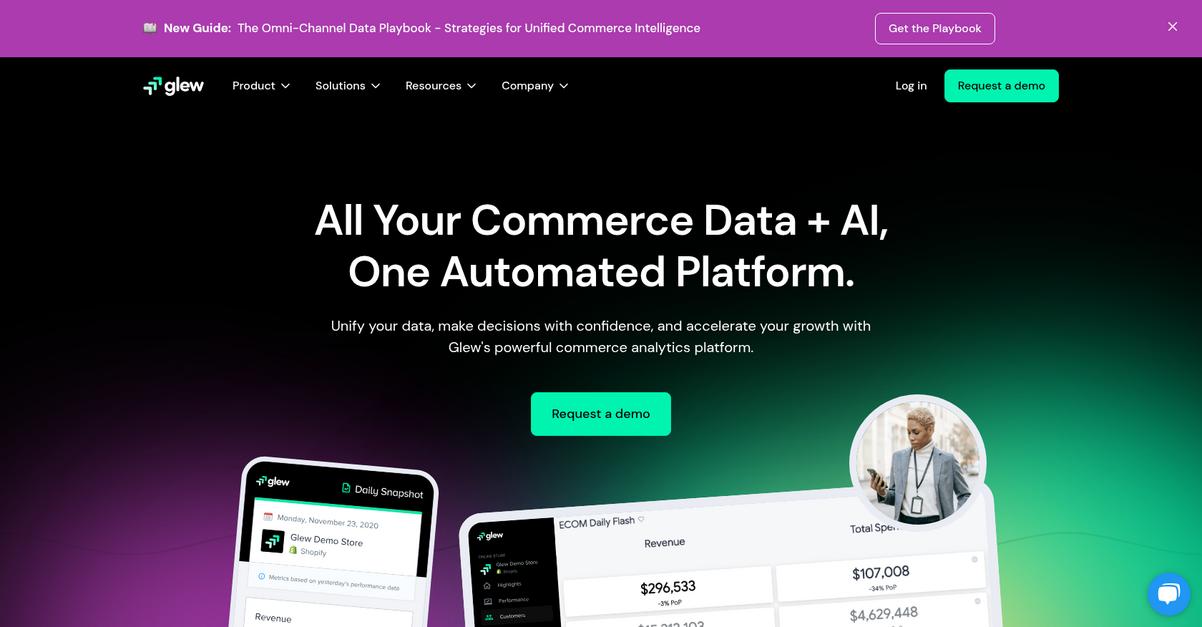
Fragmented data holding your growth hostage?
Glew addresses this by automating your entire commerce data journey, from ingestion to reporting.
This means you can say goodbye to manually consolidating spreadsheets and hello to accurate, real-time performance insights.
It’s time to unify your data.
Glew brings all your commerce data into one automated platform, leveraging over 170 integrations across your tech stack. This helps you get comprehensive insights into customer journeys, campaign performance, and conversion drivers. You can tailor reports for your unique needs with just a few clicks. Additionally, Glew offers features like daily performance reports sent straight to your inbox and robust API capabilities. The result is a unified view of your business, empowering data-driven decisions that propel sustainable growth and operational efficiency.
While we’re discussing customer understanding, my article on Deepen Your Customer Insights provides more details.
Key features:
- Automated Data Pipeline: Streamlines data integration from over 170 sources, eliminating silos and ensuring consistent, accurate insights across your entire organization.
- Unified Data Warehouse: Consolidates all your commerce data, including multi-brand and omni-channel information, into a single source of truth for comprehensive analysis.
- Customizable Commerce Intelligence: Provides out-of-the-box reports and the flexibility to create custom reports tailored to your specific business needs, powered by Looker.
Glew features, pricing, & alternatives →
Verdict: Glew stands out as one of the best ecommerce analytics tools for mid-sized brands and scaling startups, especially with its ability to unify disparate data sources and offer tailored insights. Its robust integration capabilities and automated reporting simplify complex data challenges, providing 8,000+ stores with accurate, actionable intelligence to drive significant growth.
7. Klaviyo

Are you struggling with fragmented customer data?
Klaviyo unifies all your data with its Customer Data Platform (CDP), solving your pain point of scattered information.
This means you get a complete, unified view of each customer’s full story, allowing you to anticipate their wants and needs.
This enables truly smarter decisions.
Klaviyo provides a dedicated Analytics solution, helping you understand what’s working and what’s next, without all the noise you might encounter from basic reporting. Here’s how: it includes Marketing Analytics and Benchmarks, giving you clear insights into campaign performance and industry comparisons. This means you can easily identify conversion drivers and optimize your marketing efforts. Additionally, Klaviyo AI can generate content, predict customer behavior, and optimize your strategies for higher ROI.
The result is lasting customer relationships.
If you’re also looking to maximize revenue and reach, my guide on best ecommerce marketing platform covers essential tools.
Key features:
- Customer Data Platform (CDP): Unifies all your customer data to provide a comprehensive, single view for personalized interactions and targeted marketing efforts.
- Omnichannel Marketing: Coordinates and optimizes email, SMS, mobile push, and other channels from one platform, ensuring consistent and impactful customer experiences.
- Klaviyo AI & Marketing Analytics: Leverages artificial intelligence for content generation and predictive insights, alongside robust marketing analytics for clear performance understanding and optimization.
Klaviyo features, pricing, & alternatives →
Verdict: Klaviyo’s B2C CRM platform, with its robust CDP and AI-driven insights, stands out as one of the best ecommerce analytics tools for brands seeking unified data, real-time personalization, and measurable growth. Harney & Sons, for example, saw a 114x ROI after adopting Klaviyo.
8. Adobe

Struggling with fragmented data and slow insights?
Adobe Creative Cloud’s 20+ apps and generative AI tools can help your ecommerce brand.
You can truly bring your ideas to life, which means you’re not limited by basic reporting platforms anymore.
This means actionable insights.
Adobe Creative Cloud helps by enhancing your creative content faster, enabling quicker social clips and effortless on-brand designs. This streamlines your creative workflows, allowing you to generate compelling visuals and content efficiently, which is crucial for modern ecommerce success. You can work faster in Photoshop with precise selections and instant color adjustments, directly supporting your need for high-quality marketing assets.
Additionally, with one-click animations, you can quickly create engaging content that stands out, addressing the pressure to deliver measurable ROI. The result is a unified approach to content creation that directly impacts customer journeys and conversion drivers.
Before diving deeper, you might find my analysis of data management software helpful for comprehensive business operations.
Key features:
- Access to 20+ apps and generative AI tools: This comprehensive suite helps you bring your marketing ideas to life with advanced creative capabilities.
- Enhanced creative content and one-click animations: Accelerate content creation for social media and campaigns, ensuring your brand stands out effortlessly.
- Precise selections and instant color adjustments in Photoshop: Streamline your image editing, ensuring high-quality visuals for all your product listings and marketing materials.
Adobe features, pricing, & alternatives →
Verdict: If you’re seeking to elevate your creative output and accelerate content delivery, Adobe Creative Cloud can be a valuable addition to your tech stack. While not directly an analytics tool, its focus on enhancing visual content directly supports marketing efforts, making it suitable for brands looking for the best Ecommerce analytics tools that also integrate with top-tier content creation.
9. Matomo
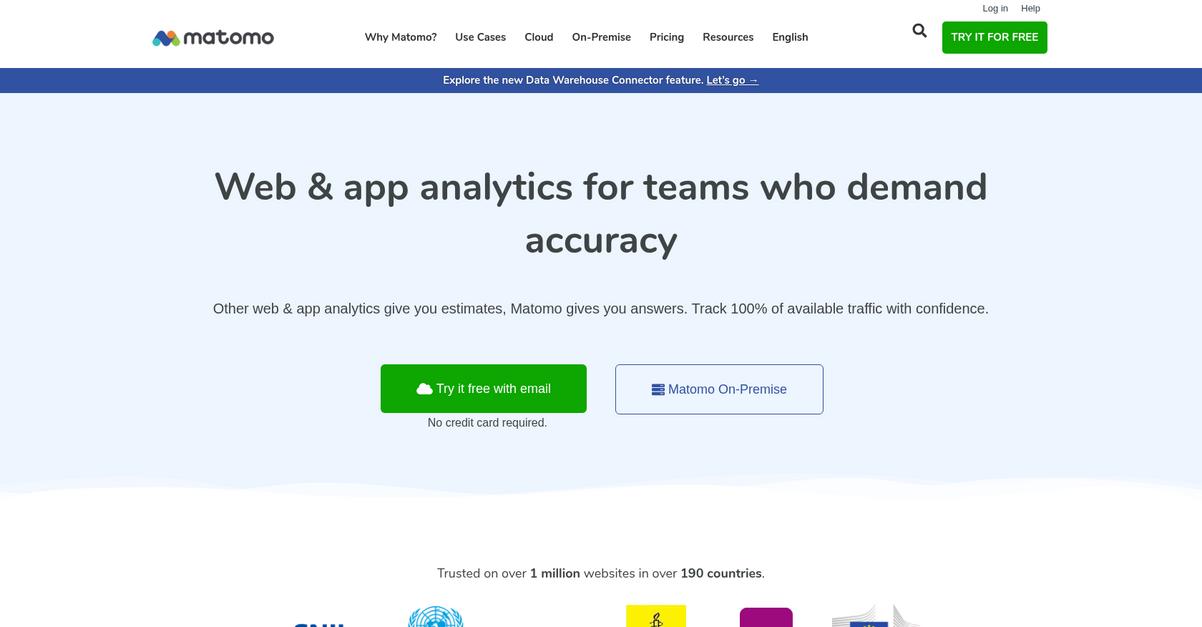
Are you outgrowing your current analytics tools?
Matomo offers web and app analytics designed for teams demanding accuracy, helping you get real answers rather than just estimates.
This means you can track 100% of available traffic with confidence, providing the complete picture of your customers.
Here’s how Matomo illuminates your data.
Matomo ensures 100% data ownership and privacy protection, letting you know where your data is stored and what’s happening to it, without external influence. This commitment includes being GDPR and CCPA compliant, and allows you to even use Matomo without needing to ask for consent. Additionally, you can securely track personal data in accordance with privacy laws, an option often unavailable with other analytics platforms. Plus, Matomo offers no data sampling, meaning you make impactful decisions based on 100% accurate reporting, providing unlimited websites, users, segments, and data storage. The result is a user-friendly interface that offers enhanced, actionable insights.
Key features:
- 100% Data Ownership: Gain full control over your analytics data, knowing where it’s stored and how it’s used, ensuring privacy and compliance with GDPR and CCPA.
- No Data Sampling: Receive 100% accurate data for all your reports, enabling confident, impactful decisions based on complete visitor behavior and campaign performance.
- Unlimited Scalability: Track an unlimited number of websites, users, and segments, with no limitations on how much data you can store, supporting your business as it grows.
Matomo features, pricing, & alternatives →
Verdict: Matomo stands out as one of the best ecommerce analytics tools for brands prioritizing data accuracy, ownership, and privacy. Its features like 100% accurate data and unlimited scalability provide the real-time, unified visibility needed to drive sustainable revenue growth and operational efficiency.
Conclusion
Your data holds the key to growth.
But choosing the right tool is overwhelming. With so many similar options, it’s easy to feel lost and risk making the wrong choice for your startup.
According to SmartOSC, advanced tools lead to improved forecasting accuracy. Making data-backed decisions is no longer optional for survival in today’s competitive market. This is where the right platform makes all the difference.
Here’s my top recommendation.
Hotjar stands out by showing you the why behind your data. It connects the numbers to real user behavior, providing the ultimate clarity you need.
I love how it blends heatmaps with user feedback. As my guide showed, HubSpot Academy even boosted signups by 10% using it. This is why it’s one of the best ecommerce analytics tools available.
For additional insights, my analysis of best content analytics software provides valuable perspectives.
I strongly recommend you start a free trial of Hotjar today. See for yourself how it illuminates your data.
You’ll finally understand your customers better.






